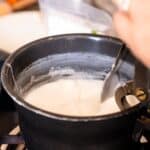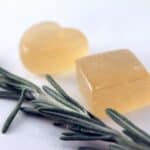When it comes to soap making, adding natural colorants is no doubt fun. The natural soap coloring shows different moods, themes, and inspirations. Colors add more meaning to the overall look of the soap and allow you to exhibit your creativity. If you want to keep your soap more natural, numerous options are available.

If you are thinking about how to naturally color soap, let me answer it. You can add botanicals, herbs, clays, powders, micas, oxides, ascorbic acid, and liquid dyes for coloring the soap. The interesting thing about natural colorants is that most of them are readily available to you in your kitchen.
Compared to synthetic colors, the natural colors are less vibrant but give a lovely tone to the soap. Natural colorants are a perfect match for various purposes. If you are interested in making other products such as bath bombs instead of synthetic dye, you should use natural colorants to get great color. The lake pigment is one of the coloring elements that we highly recommend for melt and pour soap but not for cold process soap. So, be careful in selecting any natural soap coloring element.
Now, we’ll discuss various natural elements that will enormously color your soap and will make them eye-catchy.
List of Natural Colorants
Finding natural soap colorants is not that hectic. They are conveniently available at local grocery stores, soap-making suppliers, and even in your kitchen. Many of these colorants are also used in drinks and various foods. For example, to give cheese and macaroni a lovely orange color, annatto is used while cochineal for coloring Hawaiian Punch.
1- Green Color
- Alfalfa is better to use in dried form that produces a medium green color.
- Chamomile essential oil, we also know as Blue Chamomile creates light green color.
- Chlorophyllin powdered form is good for soap making and is a superb natural pigment. Along with giving your homemade soap an eye-catchy green color, it also fills it with deodorizing properties.

- Kelp contains minute amounts of iodine and minerals and gives a remarkable natural green color to your product.
- For light green color, you can also consider ground or dried Spinach.
- Spirulina is a perfect option for getting bluish-green color.
2- Yellow and Orange Color
- Annatto, when infused with oil, creates astonishing yellow to orange color.
- Beetroot powder is a food product consisting of antioxidants that give your cold process soap excellent squash yellow color.
- Calendula is awesome for yellow streaks and comes with healing properties.
- Carrots, either used in raw or ground form, create yellowish-orange color.
- Chamomile is ideal for giving a beige to yellow color to your natural soap and can be used in powdered or dried form.
- Cornmeal, along with creating beautiful yellow color, also makes the soap exfoliate conveniently.
- Turmeric and Saffron are the natural ingredients giving pure yellow color to soap bars.
- You can use orange juice in place of water for making lye solution; it will result in light orange colored soap.
- For dyeing the natural soap in orange color, you can also use Paprika.
- Yellow Sandalwood powder will produce yellow to beige, while red powder will create a brownish-red color.
- Safflower petals make the soap dye yellow to orange in color.

3- Brown Color
- Elderberries are ideal for light brown color, so if you don’t like dark colors, give them a try. Due to its high antioxidants, it is the best natural color for your skin.
- Cinnamon and Cloves create brown color, but be cautious; both can be harsh for various skin types.
- Coffee grounds and cocoa powder are the most loved natural colorants. For more brownish natural dye, use melted chocolate or cocoa powder and finely ground coffee for brown to black color. Coffee is a superb antioxidant that can eliminate odors too. The extraction yield of coffee enables it to disperse in soap batter rapidly.
- Rose Clay produces a remarkably stunning brownish pink color that also works against the skin's impurities.
- Rosehips rich in Vitamin C give burgundy to natural brown color.
- Blue cornmeal exfoliates the skin efficiently and creates purplish-blue color to a more brownish one.
4- Purple Color
- Alkanet root, when infused with oil, gives a purple to blue color.
- The Black Walnut hull is a reliable natural food option for giving purple to black coloring to the soap. It also provides exfoliating properties to your soap.
- Madder root will give your skincare product red to purple natural food colorant.

5- Blue Color
- Indigo powder is the natural pigment giving deeper blue color to your soap which looks so stunning.
- If you are interested in creating blue shades, Woad powder should be your choice. It is one of the natural colorants widely used by blue dye lovers.
Note: Both of the above-mentioned color additives can conveniently stain, so be careful.
6- Grey and Black Color
- You can use the Poppy seeds for black specks, which are superb at exfoliating dead skin cells.
- Another excellent natural pigment, Pumice, is also an essential element for exfoliation. Pumice makes the soap look grey, making it a soothing and subtle dye for soaps.
7- Green to Brown Color
- Green tea Powder, the natural antioxidant, ensures the dyeing of the soap in brownish-green color.
- Henna, one of the plant colorants, gives olive green color or more greenish-brown color to the homemade natural soap.
- Spearmint and Sage are natural colorants that can be used as ground or dried. They are superb at adding green to brown dyes.
- Tree Lichen is available in different types. So, depending on the type you are using, it can create pink to green and, in other cases, green to brown dye.
How to Use Soap Colorants
You can infuse the soap colorants in water or oil to make the soap colorful. It is good to add the natural colorants in the lye solution to blend it perfectly into your soap. Keep in mind that the process and ingredients you prefer for soap making will determine how and when to add the soap colorants.
You can try the soap recipe that includes coconut oil, canola oil, and palm oil. If you want to keep the soap batter more white, don’t use olive oil because it can leave a yellowish tint.
Not only natural colorants but the dried petals of flowers like rose petals on top of the soap give it a distinctive look.
In the case of clays, using the right proportion is quite essential. Add clay to the lye solution and mix it thoroughly because if it is not dispersed well, the soap may crack. So, in 1 tsp of clay, put 3 tsp of water. It is beneficial to put extra water in the lye solution when adding clay to it. Clay is suitable for oily skin because of its oil-pulling properties. Soap with clay can remove skin impurities and make it smooth and soft.

Instructions About Using Natural Soap Colorants
Soap making is an art, and when it is the first time you are adding natural colorants to your recipe, you must consider the following points:
- First, mix natural colorants with the liquid oil, stir it well, then pour it into the melted hard oils.
- The other method of natural soap coloring is to add the color at tracing. When the lye solution and oils are mixed to perfection, then you can add the coloring ingredient.
- Infusing with oils is another option for this matter. You can leave the natural colorants in oils for 2-4 weeks to make it fuse naturally. But if you need instant results, gently heat the mixture to let the color release. If you prefer the room temperature method for color mixing, then never forget to stir the batter every day.
- You can add soft plant materials with a small quantity of distilled water as food colorants. But some plant materials like carrots cannot be added to the soap batter if not steamed or cooked before. There is no need to cook some food items such as avocado, just mash them up, and they will be ready to use. Add such material at light trace.
Natural Soap Colorants that Don’t Work Well
To make the natural soap, you might be interested in using fresh vegetables or fruit, but that would be quite better if you didn’t go for them. Some fruits and vegetables don’t prove to be a perfect option for natural soap colorants. Lye is an essential ingredient of soap, which changes things. When fresh fruits and lye are mixed, lye can rot them. Therefore, your entire effort ruins because the soap becomes an ugly mess and is not in a form to be used.
It is not only the case with fresh vegetables or fruits, but some dry ingredients can also create issues. There are many mints that turn bright green at first, but a few weeks later, they become brown. Lavender remains purple for some days but then turns to a more greenish color that changes, and you’ll get brown at the end. The same is the case with Rose petals which give brown shade within a few days.
Now, what to do? That question might be arising in your mind. That’s what prevents most soap makers from using plant materials in their huge batches of soaps. Rather, they rely on another option, essential oils, mostly because some of them are good at giving beautiful hues to the soap.
There is a short-lived solution; for that matter, use vitamin E oil for soaking dried herbs in it. It is not a reliable solution; as most of the time, its effect is temporary.
Are Mineral Pigments Good for Natural Soap Colorants?
Mineral pigments are the soap coloring elements that give beautiful colors to your products. Mineral pigments include ultramarines and oxides, which are safe for all skin types. In all mineral-based makeup, mineral pigments are used. However, cosmetic mineral pigments are safe to use and resemble natural minerals but are not natural. Natural minerals are not suitable for skin products because they contain heavy metals. So, cosmetic minerals are made naturally identical and are considered good for skin products.
Activated charcoal that some people consider as a mineral which in fact, it is not – is also a remarkable option for soap coloring.
Are Micas Safe Natural Colorants?
As compared to oxides and ultramarines, the micas are not that natural. Micas are of different types and are not harmful to the skin. For giving the soap a vibrant hue, you can consider micas as your next soap colorants. But if you are fond of making cold process soap, then don’t use micas because they may react in this soap-making procedure.
What Can We Expect from Natural Colorants
Natural colorants are an excellent choice for making your soaps look attractive and nicely colored. You can use any pigment of your choice to color soap but bear it in your mind that the same coloring ingredient gives different results when used with other soap ingredients. The resulting color depends on the fats and oils you are using in your soap.
The way dye will react to oils, the type of fragrances or essential oils used, and whether you allow the soap to gel or not are some other factors determining the natural colorants. So, it is not only mixing the soap colorant in the lye solution, but you’d also consider these factors if desiring to get the exact color of your choice.
Final Verdict
If you were trying to find out how to color soap naturally, you might have got the answer to your query here. Despite using synthetic colorants and conventional methods of soap coloring, use natural colorants for tremendous hues. The color strength of natural ingredients allows them to impart attractive hues to the soaps.
But it is not as simple as it seems; you should have a bit of knowledge about food science if making soap for commercial purposes. You can use raw material, either fresh or dried, for making natural melt and pour soap, cold process soap, or hot process soap. Different natural colorants respond differently when recipe changes, so first, make small batches to get experience.


